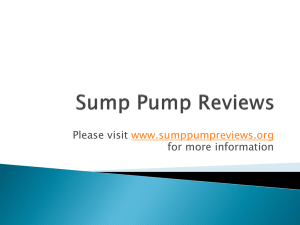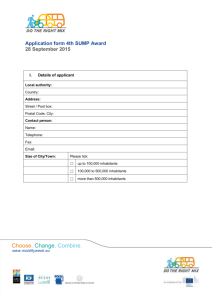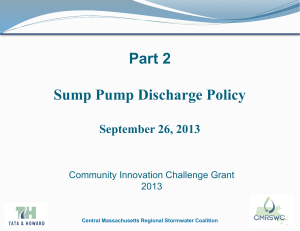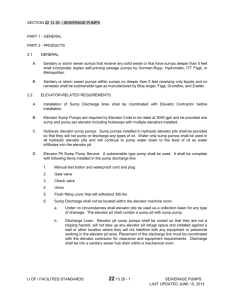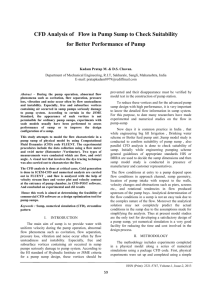DRAFT Sump Pump Central Massachusetts Regional Inspection
advertisement
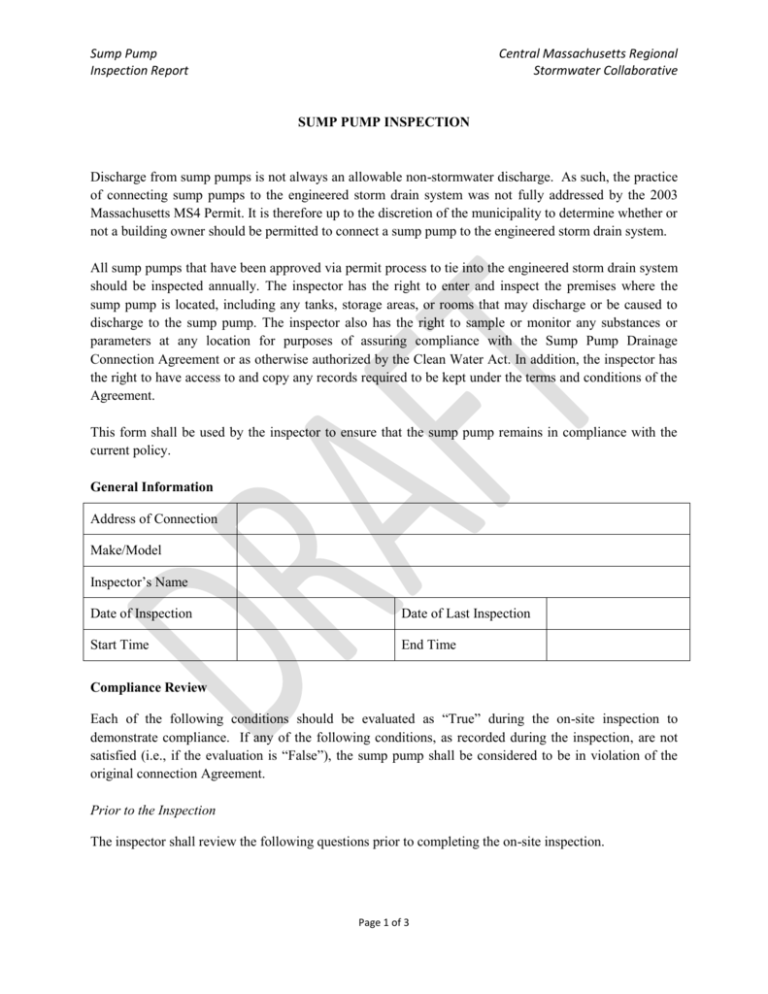
Sump Pump Inspection Report Central Massachusetts Regional Stormwater Collaborative SUMP PUMP INSPECTION Discharge from sump pumps is not always an allowable non-stormwater discharge. As such, the practice of connecting sump pumps to the engineered storm drain system was not fully addressed by the 2003 Massachusetts MS4 Permit. It is therefore up to the discretion of the municipality to determine whether or not a building owner should be permitted to connect a sump pump to the engineered storm drain system. All sump pumps that have been approved via permit process to tie into the engineered storm drain system should be inspected annually. The inspector has the right to enter and inspect the premises where the sump pump is located, including any tanks, storage areas, or rooms that may discharge or be caused to discharge to the sump pump. The inspector also has the right to sample or monitor any substances or parameters at any location for purposes of assuring compliance with the Sump Pump Drainage Connection Agreement or as otherwise authorized by the Clean Water Act. In addition, the inspector has the right to have access to and copy any records required to be kept under the terms and conditions of the Agreement. This form shall be used by the inspector to ensure that the sump pump remains in compliance with the current policy. General Information Address of Connection Make/Model Inspector’s Name Date of Inspection Date of Last Inspection Start Time End Time Compliance Review Each of the following conditions should be evaluated as “True” during the on-site inspection to demonstrate compliance. If any of the following conditions, as recorded during the inspection, are not satisfied (i.e., if the evaluation is “False”), the sump pump shall be considered to be in violation of the original connection Agreement. Prior to the Inspection The inspector shall review the following questions prior to completing the on-site inspection. Page 1 of 3 Sump Pump Inspection Report Condition Central Massachusetts Regional Stormwater Collaborative Evaluation A covenant for the property to reflect the drainage connection has been recorded at the Registry of Deeds True False Record drawings documenting the location of the discharge were supplied to the municipality after construction. True False If property has an oil/water separator: evidence of annual maintenance of oil/water separator was provided to municipality in previous period True False If property was required to complete analytical monitoring: results of analytical testing of discharge provided to municipality in previous period. True False Comment Other: During the On-Site Inspection The inspector shall make the following observations during the on-site inspection, and note the results in the table. Condition Evaluation Sump pump is used for the discharge of stormwater only True False The discharge, and liquid in the sump, is visibly free of oil or other pollutants. True False Grey water/black water is not visibly present in the discharge True False Sediment-laden surface water is not visibly present in the discharge True False Flow from the connection does not exceed approved flow True False No prohibited fixtures are connected to the municipal system from the property True False The pump presently utilized is the same as the pump approved by the municipality. True False Page 2 of 3 Comment Sump Pump Inspection Report Central Massachusetts Regional Stormwater Collaborative (continued) Condition Evaluation The pump presently utilized is the same as the pump approved by the municipality. True False Backflow preventer, cleanout, and shutoff device remain operational and easily accessible to municipality True False Comment Other: Review of Compliance with Sump Pump Policy If any of the following conditions is applicable, as recorded during the inspection, the municipality shall have the right to revoke approval of the sump pump, including grandfathered sump pumps. There is inadequate capacity of the drainage system to manage flow from the connection. Private drainage includes flow from industrial users or sources. Private drainage includes flow from multiple users, systems, or sources. The connection is located within 100 linear feet of a subsurface wastewater disposal system, such as a septic system. The stormwater outfall managing the property flow discharges to a water body identified as impaired in the most current of the Integrated List f Waters (303(d) list) or is subject to stringent local controls. The connection is located within a public drinking water Zone I. The connection is located in a public drinking water supply Zone II, and the water department or district has not approved of the connection in writing. Flow conveyed to the discharge creates a safety hazard such as ponding or freezing to vehicular, pedestrian, bicycle, or other transportation, or creates erosion or the potential for erosion. The connection jeopardizes public health, safety, or natural resources. The connection fails to meet the terms and conditions of the Agreement. Non-Compliance Actions The municipality shall provide the property owner with written notice of the violation with corrective action to be taken. The property owner shall have thirty days from the receipt of the notice to commence curative action of the violation. Page 3 of 3
